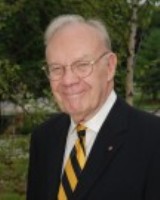Dec 29 2012
President Barack Obama named University of Missouri researcher M. Frederick Hawthorne as recipient of the National Medal of Science, the highest honor bestowed by the country to scientists. Hawthorne is the director of the International Institute of Nano and Molecular Medicine at the University of Missouri, as well as Curators' Distinguished Professor of Chemistry and Radiology.
 M. Frederick Hawthorne
M. Frederick Hawthorne
"I am proud to honor these inspiring American innovators," President Obama said in a news release. "They represent the ingenuity and imagination that has long made this Nation great—and they remind us of the enormous impact a few good ideas can have when these creative qualities are unleashed in an entrepreneurial environment."
Hawthorne was named a National Medal of Science recipient because of his work on the chemical element, boron. He developed the use of a technique known as Boron Neuron Capture Therapy, which is used in experimental treatments for cancer, arthritis and other diseases. His work with boron also has been used to fight heart disease and Alzheimer's. He pioneered the use of "boron cages," chemical structures that can be attached to other compounds and thereby change their physical properties.
"When Dr. Hawthorne came to MU in 2006, I was sure that he would advance MU's national leadership in nanomedicine and cancer research while providing break-through technology and medical solutions for the world," MU Chancellor Brady Deaton said. "This acknowledgement by President Obama of Dr. Hawthorne's work is especially gratifying and well deserved."
MU's International Institute of Nano and Molecular Medicine (I2NM2) was created largely to facilitate Hawthorne's research. Besides studies on boron, I2NM2 focuses on applications of nanotechnology in medicine, engineering microscopic motors, inventing methods to store hydrogen fuel and designing materials to store energy. Hawthorne came to MU in 2006 because the university provided a rare mix of the resources needed to carry out his research.
"The University of Missouri has three features that separate it from other universities in the country," Hawthorne said. "First, it is an example of a small number of universities in the United States with a large number of science disciplines and humanities on the same campus. Second, the largest university research nuclear reactor is located at MU. Finally, it has very strong, collegial biomedicine departments. This combination is unique."
Hawthorne will receive his award, along with 21 other recipients, at a White House ceremony in early 2013. The National Medal of Science was created by statute in 1959 and is administered for the White House by the National Science Foundation. Awarded annually, the Medal recognizes individuals who have made outstanding contributions to science and engineering. A committee of Presidential appointees selects nominees on the basis of their extraordinary knowledge in and contributions to chemistry, engineering, computing, mathematics, or the biological, behavioral/social, and physical sciences.